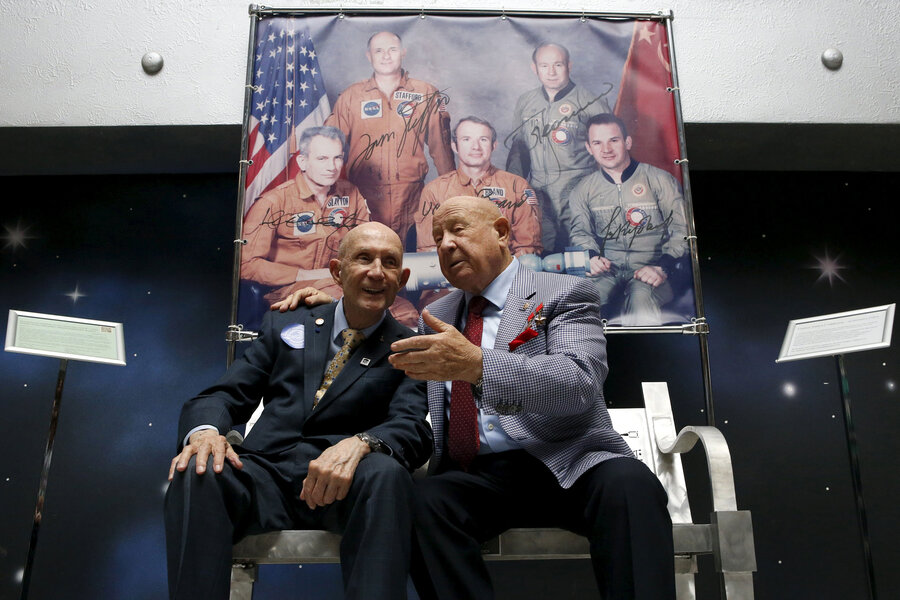Spacewalks have become routine on ISS, but that wasn't always the case
Loading...
NASA astronauts completed their second spacewalk in two weeks on Thursday, stepping out into the emptiness of space to tidy up an old radiator that had hung out on the International Space Station for too long.
Astronauts now leave the safety of their simulated, Earthlike space station regularly enough that many forget how hard scientists have worked to successfully transform spacewalks from front-page tragedies to science-beat headlines.
The first spacewalk occurred on March 18, 1965, when Soviet cosmonaut Alexey Leonov emerged from the Voskhod 2 for a 12-minute walk that nearly cost his life and that of fellow cosmonaut Pavel Belyayev.
Mr. Leonov's first moments outside the capsule were full of wonder, a literally cosmic jump that guaranteed his place at the top of the world's newspapers and shocked him with the utter vastness of space.
"The sheer size of the Earth, space. We don’t understand it on the ground. Only there you can comprehend space," Leonov told RT on the 50th anniversary of his spacewalk. “While from inside the spacecraft cosmonauts could see only a small fraction of the scenery, outside the stars and the sun are everywhere.... I did not expect all this.”
The mission grew more complicated within minutes. This was the first in-space test of the suit that Leonov later called "a spaceship shrunk to the size of a human body." Like any spaceship, the suit was heavy, requiring Leonov to exert more than 50 pounds of pressure just to close his hand. The suit itself also filled with excess air, quickly growing too large to fit back inside the door of the still-orbiting Voskhod 2.
"My suit was becoming deformed, my hands had slipped out of the gloves, my feet came out of the boots," Leonov told the BBC. "The suit felt loose around my body. I had to do something."
Risking decompression sickness and suffocation, and without telling mission control, lest the world hear of a Soviet failure, Leonov opted to release the air from his suit, shrinking it enough to step back inside the shuttle.
After the Voskhod 2's auto-reentry failed, Leonov and Mr. Belyayev landed hundreds of miles away from their target in thickly forested Siberia. They spent two nights in the sub-zero forest, surrounded by wolves and bears in the peak of mating season, before skiing their way to the safety of a rescue helicopter.
Few knew until years later the full implications – or danger – of the mission, and even Leonov's own family was confused at first about the grainy photographs of the spacewalk being broadcast around the world.
“Why is he acting like a juvenile delinquent?” his father asked journalists who gathered at his home, according to Air and Space Smithsonian. “Everyone else can complete their mission properly, inside the spacecraft. What is he doing clambering about outside? Somebody must tell him to get back inside immediately. He must be punished for this.”
Edward White would conduct the first American spacewalk three months later, on June 3, and walk for 36 minutes. The Gemini 4 mission went more smoothly than did Voskhod 2, but the American astronaut was forced to haul himself back into the spacecraft by his tether after running out of fuel in an oxygen-jet propulsion gun.
The spacesuits worn by Commander Jeff Williams and Flight Engineer Kate Rubins during their 6-and-a-half hour spacewalk on Thursday have enabled astronauts to not just problem-solve as Mr. White and Leonov did, but also complete the mechanical work of the International Space Station.
Leonov wore a Berkut spacesuit, a heat-resistant, four-layer pressure suit of nylon and rubber. He stayed tethered to his spaceship with a steel rope, an emergency oxygen hose, and communication cables. Today's spacesuits have 11 layers either sewn or cemented together, with carefully placed joints that enable the astronaut to use his or her fingers far more easily than Leonov's stiff suit. Unlike Leonov's suit, in which he sweated so much his perspiration was still sloshing near his knees upon return to Earth, modern spacesuits have spandex underwear, surrounded by water pumps that keep them cool.
"Walking" in space still represents a carefully calculated and expensive endeavor, but in today's spacewalks, retracting old radiators, tightening the bolts on a solar array, and even installing a high-definition TV camera are, as NASA astronaut Michael López-Alegría, who holds the US record for the most time spent spacewalking puts it, "all in a day's work."








